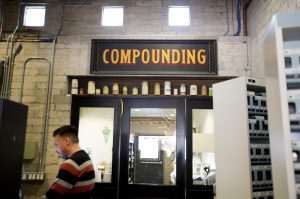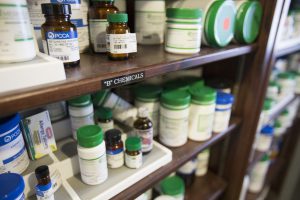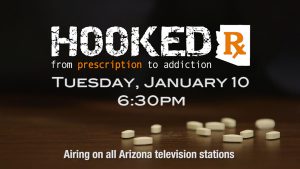The family practice doctor and medical director at Arrowhead Health Centers in Glendale said the medical community operated under the idea that compassionate physicians relieve patients of their pain, and that Americans should be pain free all the time. This mantra encouraged doctors to reach for their prescription pads and write down powerful narcotics such as Vicodin, hydrocodone and OxyContin.
Their patients demanded it and their medical training has – until recently – mostly sanctioned it. But Americans’ obsession with pain pills didn’t just start with patients and their doctors.
The pharmaceutical industry has recently come under fire from federal investigators, the public and even comedian John Oliver for its role in helping to create and sustain this nationwide epidemic.
“They’re selling out for the sales,” said Tim Morrison, a Phoenix resident whose son is recovering from an opiate addiction. “It’s all about dollars, and there is no consideration for the human element and the fact that it’s addictive.”
From 1999 to 2014, overdose deaths involving prescription pills quadrupled. In that 15-year period, more than 165,000 people died from an opioid overdose, according to the Centers for Disease Control and Prevention.
“Big Pharma” companies exert their influence in many ways. They spend billions to promote their products to doctors. They drop millions lobbying Congress and state legislators to curry favor with policymakers. And they flood television and magazines with direct-to-consumer ads to hawk their drugs.
In terms of prescription pain medication, the tactics have worked. The U.S. makes up less than 5 percent of the world’s population, yet it consumes 99 percent of all global hydrocodone and 80 percent of the world’s opioids, according to the American Society of Interventional Pain Physicians.
In Arizona, prescriptions for opioid painkillers jumped to 7.5 million in 2015 from 5.1 million in 2014, according to the Arizona State Board of Pharmacy via the Drug Enforcement Administration. The marketing of medicine is legal, but companies can step over the line.
On Dec. 8, the U.S. Department of Justice charged six former executives and managers of Chandler-based Insys Therapeutics Inc. and accused them of leading a nationwide conspiracy to bribe practitioners to unnecessarily prescribe the highly addictive fentanyl spray, Subsys, and defraud insurers, according to court documents.
Insys issued a news release that same day stating the company “continues to cooperate with all relevant authorities in its ongoing investigations and is committed to complying with laws and regulations that govern our products and business practices.” Insys representatives did not return phone calls seeking comment.
Federal and state authorities in more than a dozen jurisdictions are investigating Insys or health care employees connected to the company, according to financial statements filed with the U.S. Securities and Exchange Commission. Several of the investigations involve employees and health care professionals accused of violating the federal Anti-Kickback Statute.
Arizona Attorney General Mark Brnovich’s Office also is investigating the company, but his office declined comment.
In August 2015, Oregon Attorney General Ellen Rosenblum reached a $1.1 million settlement with Insys for deceptive marketing tactics.
“Pharmaceutical companies are profit driven,” said Assistant Attorney General David Hart, who led the Oregon Attorney General’s investigation against Insys. “They sell drugs like other companies sell lollipops. They sometimes pretend to … have a higher mission. But in fact … their goal is to make a profit. And they do so by selling drugs.”
The Pharmaceutical Research and Manufacturers of America released a statement saying prescription drugs are generally safe when taken as prescribed and for the intended purpose. It expressed its commitment to preventing abuse and called for a “balanced approach that ensures appropriate treatment of pain while also addressing this critical public health challenge,” according to its website.
By 2020, the global market for pain management pharmaceuticals is expected to reach $40.4 billion in revenue, according to BCC Research, a market research company. It’s also projected to grow – or at least stay constant – because of an aging population, an increase in patients with cancer and chronic pain, and health care advances that allow people to live longer.
Dr. Dan Malone, a pharmacoeconomist and professor at the College of Pharmacy at the University of Arizona, said it is difficult for the medical community and the pharmaceutical field to find a balance between easing a patient’s pain and preventing abuse.
“There’s no silver bullet here – no miracle drug that we can give that basically walks that line very well,” he said.
Influence on doctors
Gina Berman, a former emergency room doctor, said there was a time when pharmaceutical company sales representatives would do more than just leave their company pen on the doctor’s table.
“My father-in-law is an internist in Wisconsin, and when he was practicing, when my husband was younger, they would go on vacations,” said Berman, who is now the medical director of Giving Tree Wellness Center, a Phoenix-based medical marijuana dispensary. “There were lots of perks to dealing with the drug companies, and that has really been done away with.”
For years, it was normal practice to wine and dine doctors. Some of the nation’s leading pharmaceutical companies, such as Pfizer and Purdue Pharma, used the tactic.
Purdue debuted the narcotic OxyContin in 1996. The powerful painkiller gained momentum through heavy marketing approaches and topped sales revenues at $31 billion, according to The Los Angeles Times.
Purdue successfully expanded the use of OxyContin from cancer patients to a larger and ever-increasing population of chronic pain patients via doctor prescriptions.
They also succeeded in making doctors and consumers more aware of the narcotic, however misinformed, and changed the pharmaceutical industry. Other companies adopted the same kinds of practices.
A 2016 article in the journal Drug and Alcohol Dependence stated that many doctors “may be receptive to such marketing because their baseline knowledge of pain management and addiction treatment is low” and that veterinarians receive far more education and training in pain management than medical doctors.
Berman noted that there was a “dramatic increase in the use of opiates” from the time she started medical school in 1997 to the time she completed residency in emergency medicine in 2004
Malone said the medical community had withheld a lot of the potent pain medications to the point where patients were living and dying in pain – many said unnecessarily.
“Numerous studies that came out 20 years ago emphasized the fact that patients weren’t getting appropriate treatment,” Malone said. “Then the pendulum kind of swung, and perhaps too far the other way, where we were treating patients with these medications that probably shouldn’t have been on them long term.”
When Purdue introduced OxyContin, sales representatives and promotional ads said that less than 1 percent of people would ever become addicted to OxyContin, according to a 2009 article by Dr. Art Van Zee, an internist certified in addiction medicine.
“They were falsely promoting opioids as safe and effective for conditions where opioids are not safe or effective,” said Dr. Andrew Kolodny, executive director of Physicians for Responsible Opioid Prescribing, a national advocacy group for proper prescribing methods.
The medical community began encouraging doctors to alleviate their patients’ pain and introduced the pain assessment scale and patient satisfaction surveys. It became understood that compassionate doctors took care of their patients’ pain, fast. In other words, they prescribed painkillers.
The surveys ask, “Was your pain handled adequately?” Doctors who do not receive satisfactory results from the surveys are often reprimanded or can even lose their jobs, Berman said.
Doctors have said they often do not receive adequate training on how to deal with chronic pain, and the training they do receive is often sponsored by pharmaceutical companies.
That aspect hasn’t changed much.
“In many ways, that education is still dominated and influenced by the pharmaceutical industry,” Kolodny said. “Most of the education is still pretty bad.”
But since the 1990s, Kolodny said the medical community has grown more skeptical of industry influence and has turned to other ways of learning about new drugs.
“You read medical journals not sponsored by the pharmaceutical companies,” Berman said.
As more people became addicted to opioids and overdose deaths skyrocketed, authorities began cracking down on some of these companies.
In 2007, 27 attorneys general settled a multi-million dollar lawsuit with Purdue for illegal and deceptive marketing tactics and for misbranding their product. “We made our mistakes in the past and accept responsibility for that,” said Bob Josephson, a spokesman for Purdue Pharma.
Although several Valley doctors said they don’t see the same aggressive marketing tactics popular decades ago, the industry still pushes hard.
Johnston, the family practice doctor in Glendale, said sales representatives continue to stop by the office.
“There’s pressure from pharmaceutical companies all the time on doctors,” Johnston said. “They’re always trying to knock on your door and talk to you about the latest and greatest.”
Kolodny said the companies have new ways to incentivize doctors to keep writing prescriptions for their products.
“It’s not like they’re paying you to write a prescription,” Kolodny said. “They might say to a doctor, ‘We want you to give a dinner talk for some of your colleagues at this really nice restaurant so you can talk about your experience treating these conditions because you’re such an amazing doctor.’”
Kolodny called the accusations against Insys, the Chandler-based company, unique.
“They literally bribed their doctors to prescribe their drug,” he said. “That’s usually not the way it works with pharmaceutical companies.”
In a news release, Illinois Attorney General Lisa Madigan said the state’s case against illustrates Insys’ disregard patients’ health: “It’s this type of reprehensible and illegal conduct that feeds the dangerous opioid epidemic and is another low for the pharmaceutical industry.”
The Arizona company, which distributes its products nationwide, had a team of about 75 full-time research and development personnel and 343 full-time marketing and sales employees. It spent nearly $2 million in legal fees in 2013. Two years later, legal fees jumped to just under $19.5 million, according to financial records.
From 2014 to 2015, net revenue increased $122.8 million, or 124 percent.
“They just want to make the money,” Berman said. “This is a company. This is a business. This is not about caring about people. This is about a bottom line.”
However, Malone said it’s not uncommon to see a few companies make huge strides in revenue if they manufacture a novel drug.
“It’s probably a function of meeting an unmet need,” he said. “There was obviously huge demand for the product, and it made an impact in patients’ lives.”
The need to lobby
The U.S. pharmaceutical industry is a relatively small segment of the nation’s economy, yet the U.S. holds nearly 40 percent of the global pharmaceutical market and generated $413 billion in 2015, according to industry analysts.
Pharmaceuticals and health products, along with tobacco and defense, are considered the top three “high-intensity” industries – industries that have a big need to lobby.
“They don’t employ that many people,” said Maksim Soshkin, a senior analyst at IBISWorld, a national industry research provider. “They don’t bring that much (gross domestic product) to different states. They rely on government policy and spending as part of their business. They need to lobby a lot.”
Pharmaceutical companies spent more than $880 million on lobbying and federal and state political contributions over the past 10 years, according to the Associated Press and the Center for Public Integrity. The industry supported some legislation, such as bills that would enforce abuse deterrent opioids, and it opposed others, specifically those that would impose more regulation on drug-making policies, according to the investigation.
“They’re paying major lobbyist dollars to influence Congress so that the restrictions do not exist. It’s an epidemic in itself,” said Morrison, the father of a recovering addict.
Mike Gardner, a principal at Triadvocates, a lobbying and public affairs consulting firm in Phoenix, said the pharmaceutical industry is misunderstood. He said money may give lobbyists a leg up, but it doesn’t guarantee the passage of any bills.
“It’s not unusual for people to take your money and vote against you,” Gardner said. “They listen to you first and then they vote against you. But, hopefully, if you have a reasonable story to tell and you have access, you’ll have moved the needle a little bit in that lawmaker’s mind, but there’s no guarantee that you absolutely will.”
Eighteen of the Top 25 global pharmaceutical companies have contracted a lobbyist to work in Arizona, according to data from the Secretary of State’s Office.
Pharmaceutical companies also participate in local politics. For example, Insys donated $500,000 to the anti-recreational marijuana campaign, which opposed and successfully blocked the legalization of recreational marijuana in the November 2016 general election. Insys plans to release a synthetic pot compound, Syndros.
‘Ask your doctor’
Following major legal battles that targeted deceptive marketing practices, Berman said she noticed a switch in how companies advertised drugs. The focus turned from the doctor to the patient.
“There has been a lot of push in terms of advertising to the patient themselves,” she said. “And patients will come in, and they will ask for particular medications because they’ve seen the commercial for it.”
Since the 1990s, patients have learned about new medications because of direct-to-consumer pharmaceutical advertising.
The U.S. is one of just two countries that allows direct-to-consumer advertising. The pharmaceutical industry spent $5.4 billion on direct-to-consumer ads in 2015, according to Kantar Media, a research, data and insight company aggregate.
This type of vigorous advertising does two things: It encourages patients to seek medical advice, which shoots up the number of doctor visits, and ultimately, increases the demand for drugs. Second, it “urges patients to talk to the doctor about the advertised drug, which can potentially steal market share from competition,” according to a 2009 article from the National Center for Biotechnology Information.
Hart, the assistant attorney general, said although it may not be in the public health’s best interest, drug companies have a lot of freedom in their advertising.
“We have a First Amendment,” Hart said. “Part of the First Amendment is you can’t limit non-deceptive speech, even commercial speech.”
Future and solutions
Federal and state officials have made strides in trying to slow prescription pill abuse.
In July, President Barack Obama signed the Comprehensive Addiction and Recovery Act, which focuses on prevention, treatment, law enforcement, recovery, criminal justice reforms and overdose reversal.
In May, Arizona Gov. Doug Ducey signed two bills into law: one that improves the tracking of prescription medication and one that allows greater access to naloxone, a drug used to reverse the effects of an overdose. Ducey also gave an executive order in October that limits the first fill of prescription pills to seven days’ worth in some cases.
Other federal agencies have strengthened regulations as well.
But some critics, like Morrison and Kolodny, said the government, specifically the U.S. Food and Drug Administration, hasn’t gone far enough – especially when it comes to regulating pharmaceutical companies.
“I believe in capitalism,” Kolodny said. “It’s the right model for the economy, but I think that corporations need to be regulated, so that they don’t wind up harming the public in their pursuit of profit.”
In response to recent litigation and increased awareness of prescription drug addiction, some major pharmaceutical companies are investing in research and development of abuse-deterrent opioids.
Josephson, the spokesman from Purdue, pointed out that his company has worked to address the opioid crisis for more than a decade.
He said the company’s products represent about 2 percent of all opioid prescriptions, but they’ve “led the pharmaceutical industry in developing medications with abuse-deterrent properties.” In an email, he said the FDA, DEA and White House consider the medications “an important part of a comprehensive approach.”
Malone, the professor at the University of Arizona, explained these new formulas. “Most of the products we’re seeing come out now, at least in the opioid space, are the different formulations of existing molecules,” he said. “It’s in a tablet that can’t be crushed or it’s combined with another agent that, if it were crushed or used, it would negate the medication, and you wouldn’t get the high when you use the medication.”
Kolodny said although the pills may be more difficult to crush and snort, they are not any safer or effective for chronic pain.
“These drugs, they’re just as addictive,” he said. “What they’re really doing is profiteering off of concern by coming up with a new expensive technology that they can patent and try to get their new (abuse-deterrent formulations) prescribed.”
On the doctor front, Kolodny said prescribing levels haven’t gone down, but he believes that things will start changing soon.
“The message is getting out that we shouldn’t be treating back pain and headaches and fibromyalgia with long-term opioids,” he said. “The trickier thing is that we have about 10 to 12 million Americans who were put on long-term opioids, and many of these people may never be able to come off opioids.”
As for the 1.9 million Americans already hooked on prescription pills and countless others who diverted to heroin, the future and the solution are uncertain.
“That’s the really hard part,” Kolodny said.
Cronkite News reporter Danielle Kernkamp contributed to this article.
^__=






